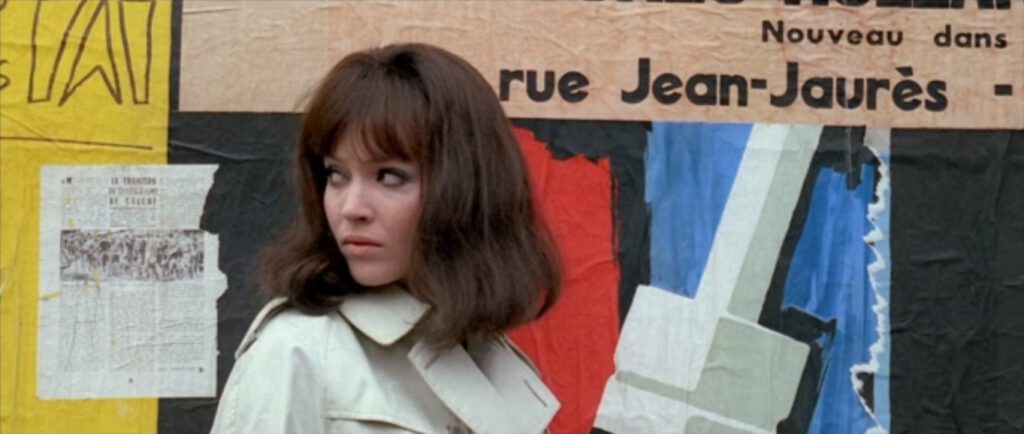
Made in U.S.A
1966, directed by Jean-Luc Godard
The first step toward making sense of Made in U.S.A is to ask why it’s set in Atlantic City of all places. The film is loosely adapted from The Jugger by Donald Westlake, which is set in Nebraska. It’s an odd choice, especially without the least effort to make the Parisian settings look American, much less like the gambling spot in New Jersey. At least Atlantic City goes with all the other non-sequiturs, and it sounds seedy enough to fit the noirish plot, but there’s something else – a small tweak to the name reveals a connection that can hardly be coincidental. The French word for “city” is “ville”, so abbreviating “Atlantic” and switching the “A” to Greek gives us “Alpha-ville”.
Like Alphaville, which Godard made a year earlier, Made in U.S.A is about a trench-coated journalist (or faux reporter in Alphaville) seeking justice in a faraway city. Both movies mix Godard’s interests in politics, cinematic devices, and syntax with a stylized comic-book world of guns, booze, fast dialogue, and pretty women. Both use locations in greater Paris to stand in for a much different city. Both feature disembodied voices (the Alpha-60 computer and Paula’s murdered lover Richard P.) spouting absolutist ideology through a machine with rotating tape reels. Both end with a man and a woman driving off down a highway, and they share overlapping casts with Anna Karina, László Szabó, Jean-Pierre Léaud, and Ernest Menzer.
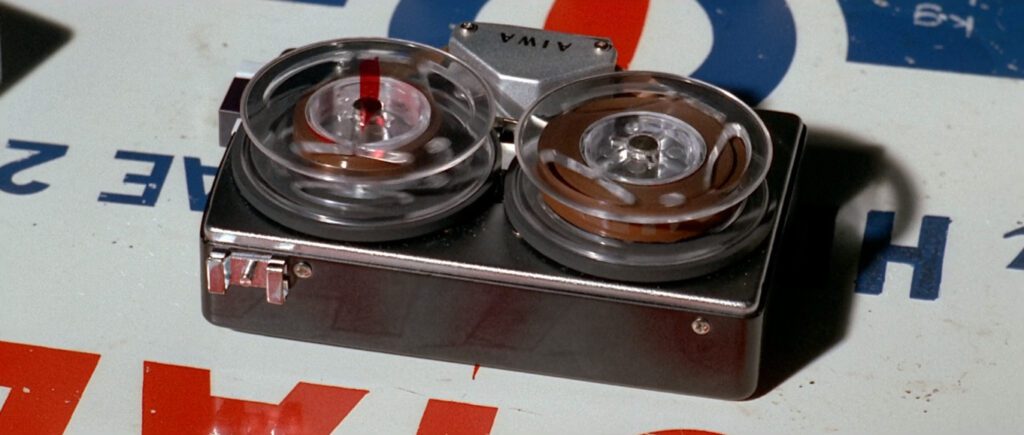
Godard and his cinematographer Raoul Coutard shot Made in U.S.A concurrently with 2 or 3 Things I Know About Her, which also alludes indirectly to Alphaville with its reference to galaxies, its setting in a “city of the future”, and its substitution of Juliette Jeanson for Ivan Johnson. Neither film is exactly a remake nor a sequel to Alphaville – each of them, rather, represents a conscious effort to extend the thinking behind Alphaville, which in 1965 was Godard’s most philosophical film to date, a movie about the way people think, and an attack on the use of language to oversimplify reality.
The first word spoken in Made in U.S.A is “le bonheur” (happiness), which happens to be the solution to the riddle that defeats Alpha-60 in Alphaville. The action in Atlantic City ends with the word “sadness” when Paula Nelson kills David Goodis outside the villa. If we exclude the two concluding scenes – Paula’s tape recording and her ride down the highway with Philippe – the story is bracketed by these two words which are normally taken as opposites. The city of Alphaville was above all a land of opposites (cold & hot, north & south, black & white, lights blinking on & off, etc.) governed by a computer that thinks in ones and zeros – and we’re meant to understand that Atlantic City is the earthly equivalent of Alphaville. Here too the dialogue and setting keep returning to oppositions: police and gangsters, communists and fascists, cold and hot (when Paula searches for Widmark’s tape), day and night (the action takes place in September near the equinox). In Paula’s monologue about morality at the bar she speaks of silence & words, departure & presence, indifference & help, concern & thoughtlessness, nothing & everything.
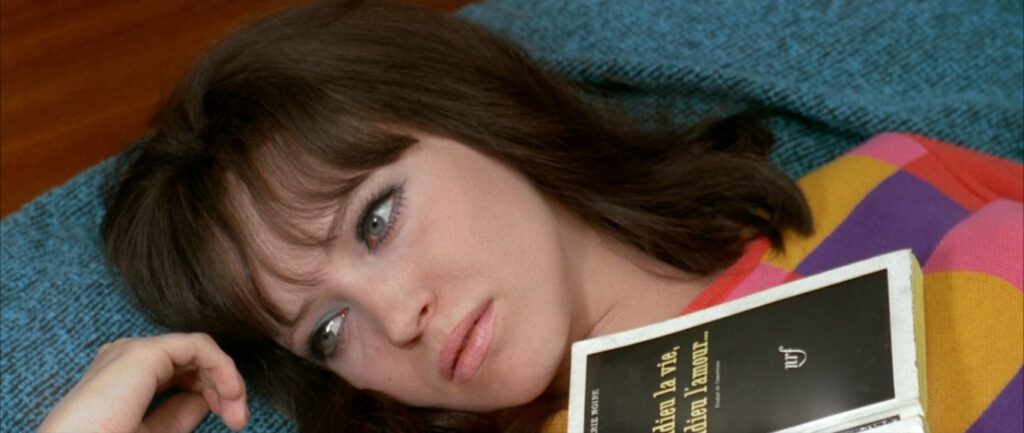
With its bright colors and its plentiful jokes, Godard’s version of Atlantic City may lack Alphaville’s dystopian oppressiveness, but that doesn’t make it a better place. Neither the axes of opposition nor the forces of tyranny are as obvious as in the earlier film, but their effects are more tragic here, and the movie is more true to life – not only because it’s set on Earth, but because it eschews the triumphalism of Alphaville‘s ending. Even more than opposites, the movie is full of absurdities. A Japanese chanteuse hides in Mr. Typhus’ hotel bathroom playing guitar; a bloody skeleton sits in Dr. Korvo’s office; a gangster goes around playing with a toy puzzle; Marianne Faithfull appears for no reason in a barroom singing As Tears Go By; and Paula, played by Danish-French actress Anna Karina, is supposed to be from Agadir in Morocco. Asked how long he was in Paris, David Goodis replies “127 years”, launching a flurry of nonsensical exchanges. A laborer gets into a philosophical conversation with a bartender, leading to a string of meaningless sentences like the radio messages in Cocteau’s Orphée (a movie that Alphaville alludes to liberally) – e.g. “The barman is in the pocket of the pencil’s jacket.”
Godard has a way of being comical and deadly serious at the same time – think of the bumpkins in Les carabiniers going off to war, excited about breaking children’s arms and burning women. The absurdities we see in Atlantic City may be amusing, but they also represent a violent and anti-social world that corrupts everyone in it – again much like the city of Alphaville. Godard seems to have been fully aware of Voltaire’s dictum, “Those who can make you believe absurdities can make you commit atrocities,” and in fact Paula ends up participating in Atlantic City’s ubiquitous violence, killing two unarmed men: the juvenile fascist Donald Siegel and the self-absorbed writer David Goodis.
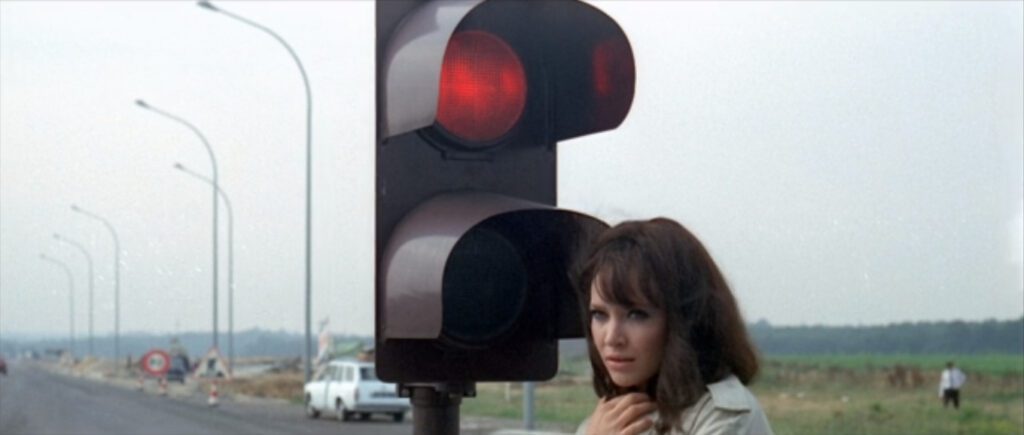
When the film finally cuts away from Atlantic City, Paula finds herself stranded at a tollbooth on a French highway, as if leaving the fictional world behind and entering reality – a reality expressed in Bazinian style through the switch to naturalistic cinematography and the unbroken three-minute final shot as she rides off with Philippe. At the tollbooth Paula stands in front of a traffic signal speaking of her conscience; both the traffic light and the word “conscience” are key elements of Alphaville.
The arc of Made in U.S.A is a journey of conscience, as Paula’s awareness blossoms the same way Natacha had emerged from the stupor of Alphaville. In French “conscience” includes the English meaning (awareness of one’s actions), but it’s also synonymous with “consciousness”, including the sense of “political consciousness”. All of these meanings apply simultaneously to Paula. In the early scenes she bullies Mr. Typhus, David Goodis, Dr. Korvo’s assistant, and Dr. Ludwig, but when she’s knocked unconscious near the gangsters’ garage she begins to think of how strange and unnecessary all the antagonism around her is:
“Where am I? I am traveling across countries full of blood. War is war, no matter what it’s called. War… and life? Has it been anything apart from war? Killing less than war, is that the rule in this life? Where am I?”
At the end she examines her conscience, reflecting on the murders she committed, and the last lines reflect an opening onto a greater political consciousness. Philippe suggests that the political terms “left” and “right” are obsolete, and Paula asks, in the final line, how we can replace them. Like Lemmy Caution’s riddle at the climax of Alphaville, her question challenges us to find a new way of thinking that transcends the false simplicity of opposites.
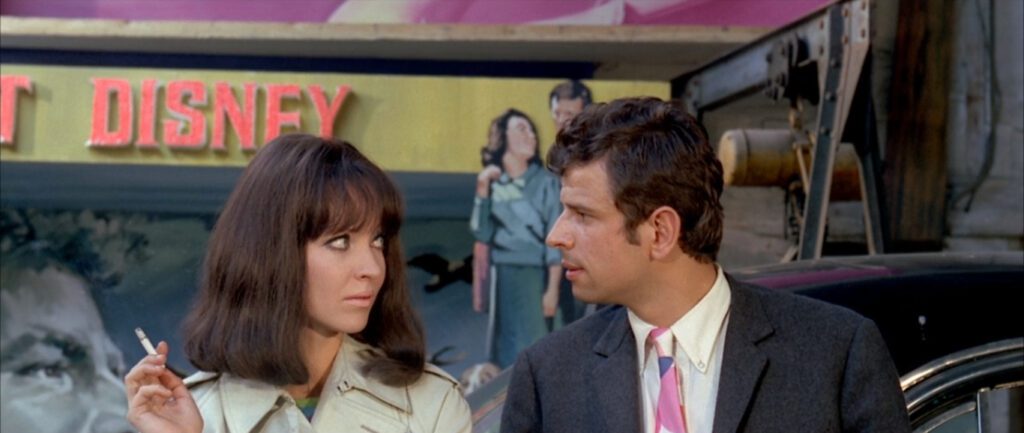
As the story traces Paula’s growing consciousness, it’s simultaneously a search for meaning. Her mission is to investigate the death of her lover Richard P., and she says that “To find out why Richard died was to find out why I would live.” Her ultimate emergence from the city of absurdities allows her a chance to find meaning. The movie doesn’t take her that far, but her question at the end is a sign of progress.
It’s not incidental that the scenes in Atlantic City are so full of allusions to both politics and movies. Characters are named after Robert McNamara and Richard Nixon, and the movie alludes to WWII, the Algerian War (indirectly, with Morocco standing for Algeria), and the Vietnam War, as well as the disappearance of Mehdi Ben Barka. Both France and the United States are implicated in the horrors of history, but the title Made in U.S.A – plus the abundant references to Hollywood, which is also singled out at the end of 2 or 3 Things I Know About Her – point a finger at the United States as the source of the absurdities corrupting the present age. Until recently Godard had been a champion of Hollywood cinema, and his dedication of Made in U.S.A to Nicholas Ray and Samuel Fuller reflects a gratitude for the lessons he learned from his favorite American directors, but with the Vietnam War underway it’s easy to read a souring of his opinion toward the United States and toward Hollywood as tyrannical forces shaping the way people think, and like Alpha-60, oversimplifying people’s worldviews.
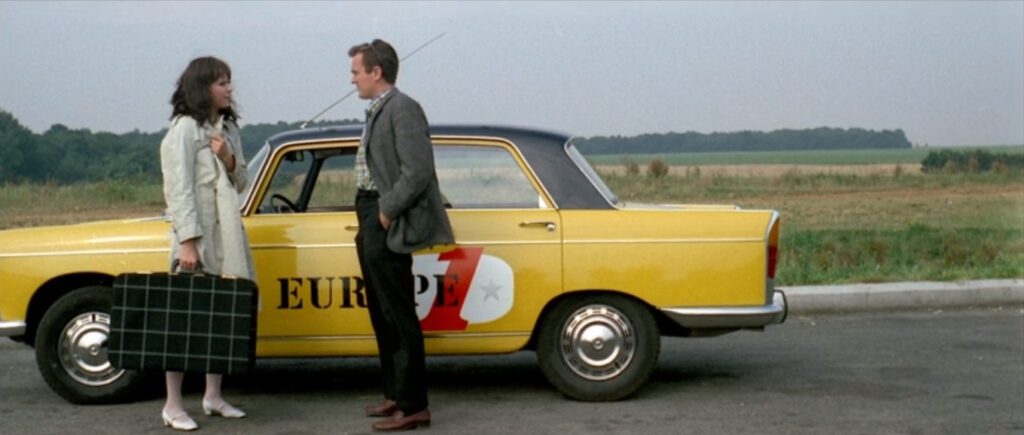
Godard’s battle is not with the left or right per se. Although his politics lean left, he will soon take a swipe at the reflexiveness of revolutionary leftism in La chinoise (1967). Rather he is fighting against forces that strip the nuance and complexity of reality from political thought – forces that encourage people to embrace received ideologies stupidly. This should not be mistaken for both-sides-ism or ambivalence: his approach is synthetic, much like that of early French socialist Jean Jaurès, whose name appears prominently on a poster behind Paula immediately after the opening scene. In Alphaville, the name of secret agent Lemmy Caution evoked the middle signal of a traffic light, the yellow light that mediates between the opposites of “stop” and “go”. The light behind Paula at the tollbooth only has two colors, red and green, representing the binary thinking that governs computers, Cold War politics, Hollywood’s fixation on good and evil, the cruel world of Godard’s fictional Atlantic City, and the poverty of language in general when ideological forces strip it of its richness. Until now there’s been no Lemmy Caution mediating between opposites, but suddenly Paula’s friend Philippe drives up in a bright yellow car with “Europe” painted in large letters across the sides. In the last lines Philippe will open the door to a synthesis between the old categories of “right” and “left” – implying a hope that in a world dominated by American and Soviet ideologies, Europe will play the role of Lemmy Caution, stepping in to forge a new way of thinking beyond those opposite poles.
CONNECTIONS:
Orphée – Series of short meaningless but enigmatic sentences
A Woman Is a Woman – Character who says he’s been in a place for 27 or 127 years
Alphaville – Reporter on a mission in a strange and corrupt city; similarity of city names; authoritative voice from a tape recorder; profusion of opposites; traffic light
2 or 3 Things I Know About Her – Transformation of Alphaville‘s dystopia into mundane reality; search for meaning in a meaningless world